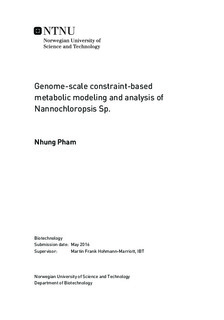Genome-scale constraint-based metabolic modeling and analysis of Nannochloropsis Sp.
Master thesis
Permanent lenke
http://hdl.handle.net/11250/2399905Utgivelsesdato
2016Metadata
Vis full innførselSamlinger
Sammendrag
Genome scale metabolic models provide a link between genomic and metabolic information. Theconstraint-based approach is increasingly important for quantitatively analyzing the essential aspects of metabolic pathways, for example finding the reaction fluxes. This thesis was aimed at constructing a genome scale metabolic model for Nannochloropsis, a unicellular marine alga that offers a potential feedstock for biofuel production due to its high lipid content. The model reconstruction was carried out following a procedure outlined by Thiele, I. and Palsson B.Ø. in 2010 [1]. After obtaining an automatically generated model using the PlantSeed platform, this draft reconstruction was manually curated. The final model consists of 383 genes cover 4.8% of the total gene in the genome. A total of 987 reactions and 1024 metabolites are included in the model and were assigned to biochemical pathways. All gaps related to the synthesis of biomass precursor were eliminated. At this stage the model can synthesize 70 out of 89 biomass precursors. Since Nannochloropsis is interesting as a possible producer of lipids to be utilized in biodiesel production, the synthesis of triacylglycerol (TAGs) had a special focus in this project. The TAG synthesis was reconstructed as accurately as possible. Using this model, TAGs is produced at the flux rate of 23.0138. The generated model shares some common characteristics with models of other photosynthetic organisms. These common characteristics include network topology, distribution of reactions and metabolites in compartments and pathways. The thesis provides the first genome-scale metabolic model for Nannochloropsis, and is a starting point for future improvement and validation for an accurate simulation of lipid and biomass production.
